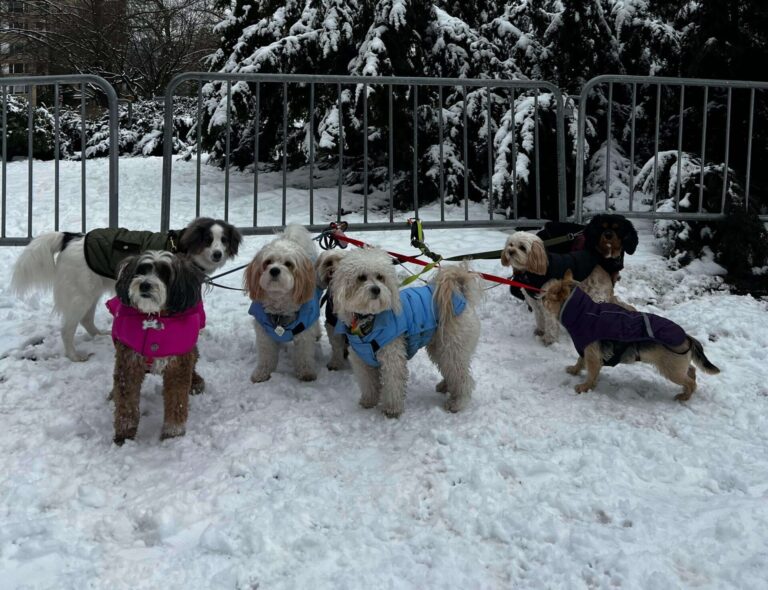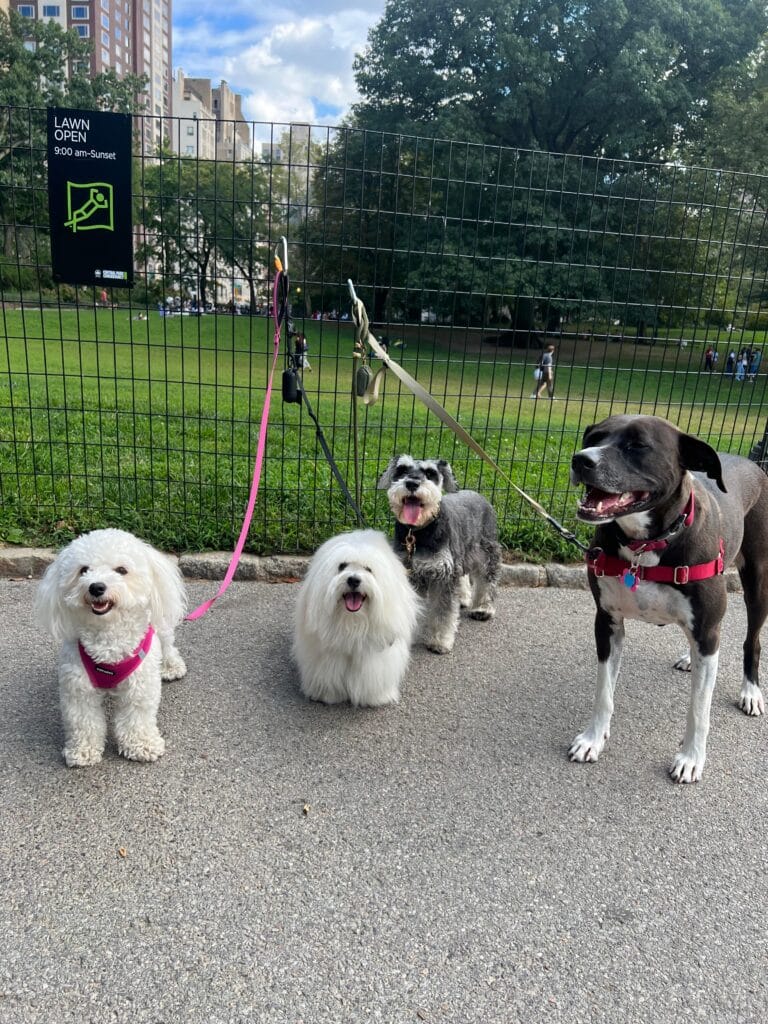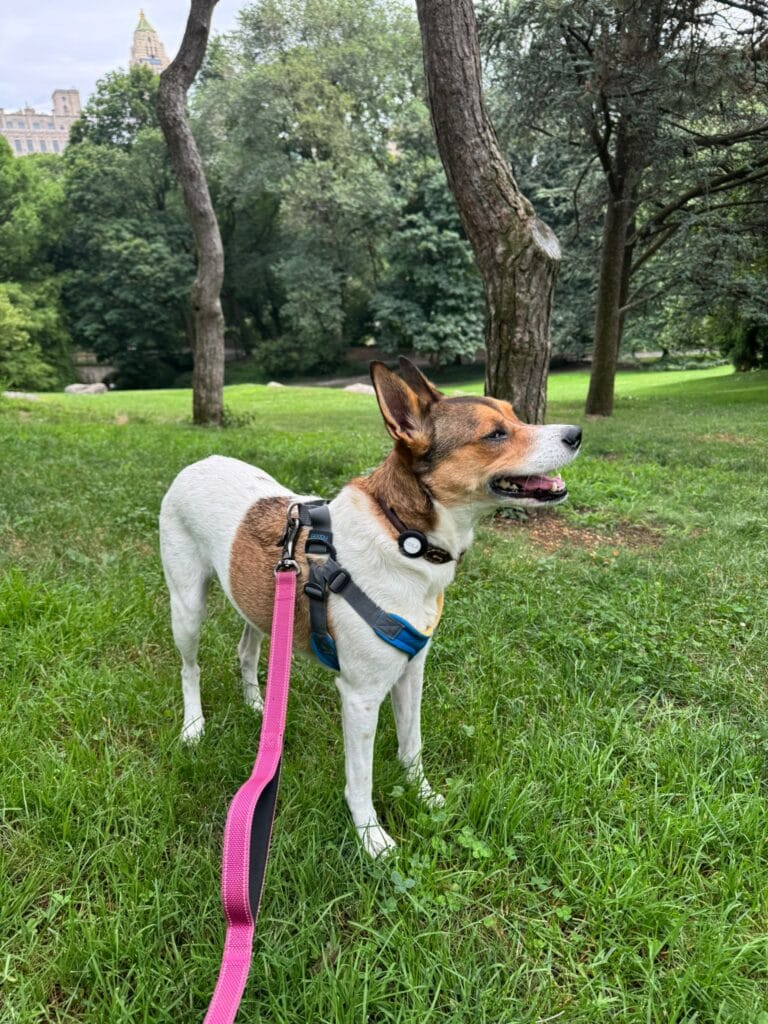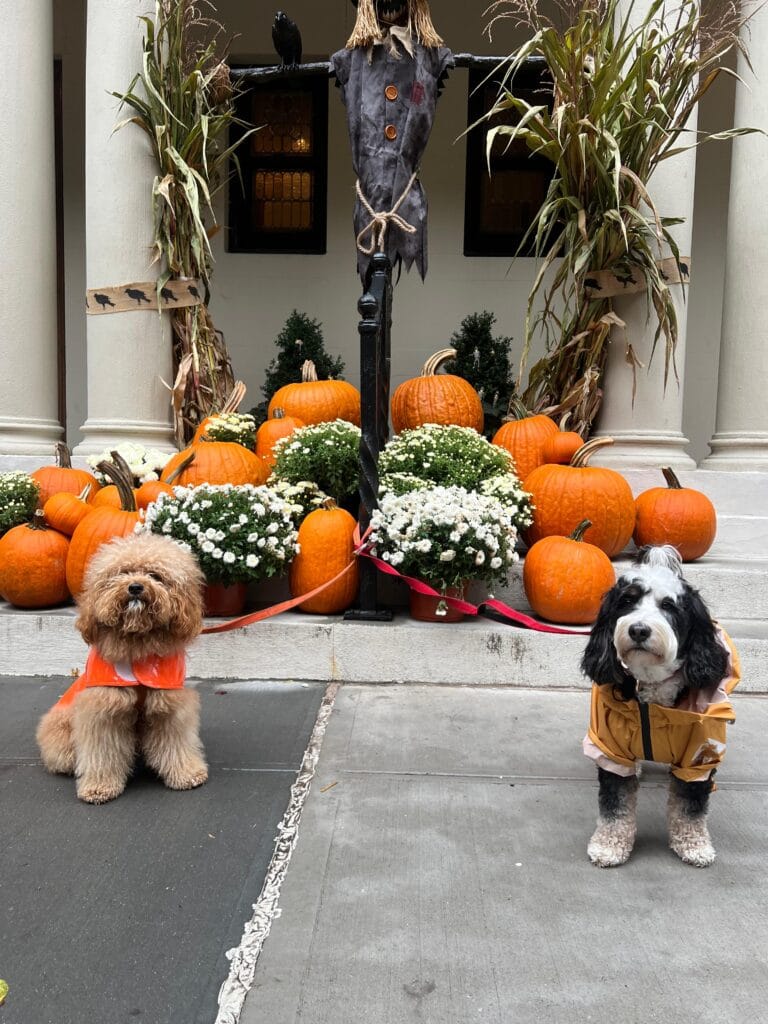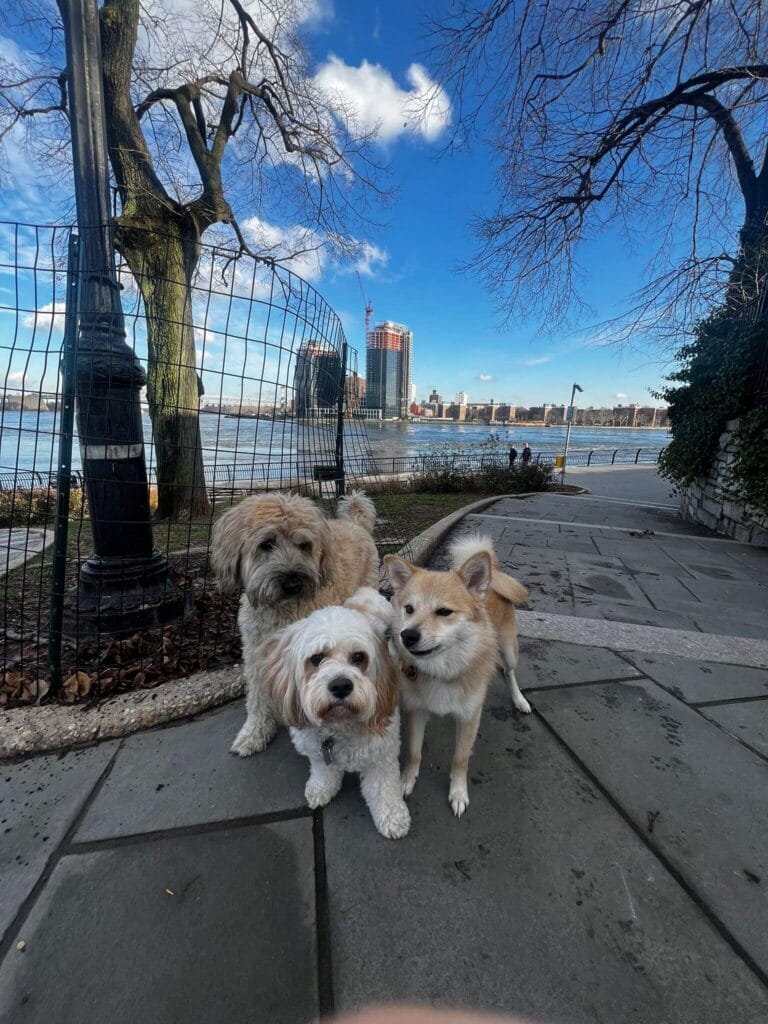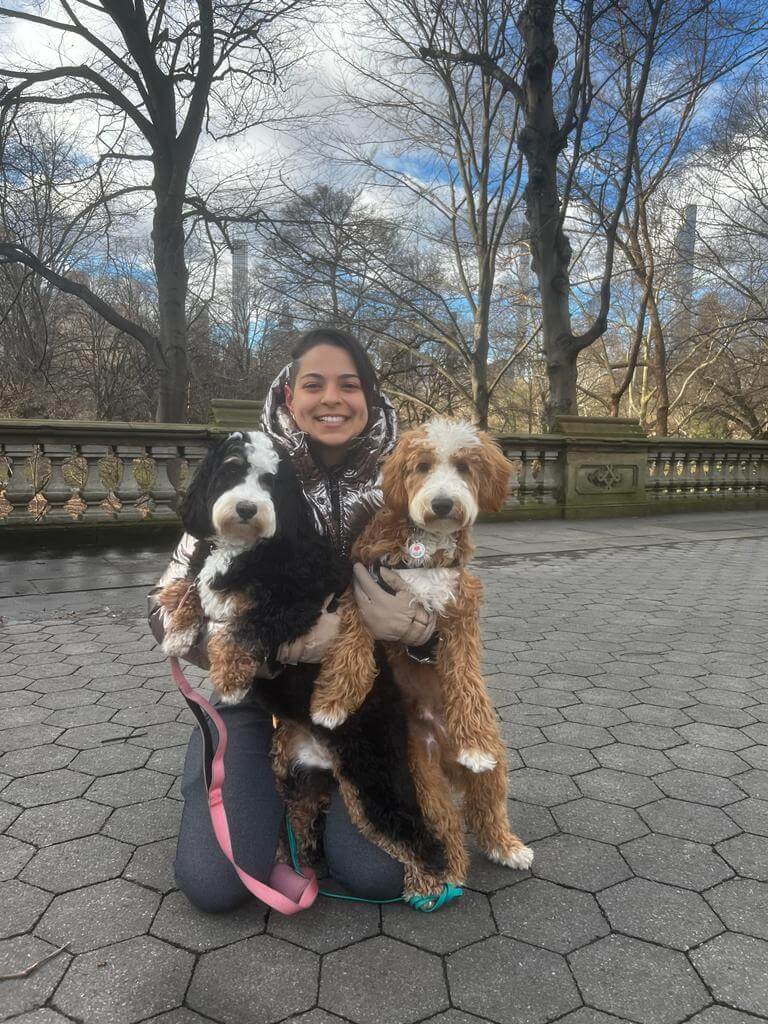Ever found yourself playing an impromptu game of “dodge the taxi” while walking your Goldendoodle down 5th Avenue? If you’ve ever navigated NYC with a four-legged friend, you know it’s basically an extreme sport.
Let’s be real – walking your dog in the concrete jungle comes with its own special brand of chaos. From unpredictable traffic to sidewalks packed tighter than the 6 train at rush hour.
These dog walking tips for NYC streets might just save you from that awkward moment when Fido decides to greet that important-looking person in the suit while you’re tangled in the leash.
The city that never sleeps doesn’t slow down for dog walkers. But what most New Yorkers don’t realize about their daily dog walks is actually the most important part…
Essential Safety Gear for Urban Dog Walking
High-visibility leashes and collars that stand out in traffic
Walking your pup in NYC is like navigating a concrete jungle. Cars zoom by, bikes weave through traffic, and pedestrians rush past. For expert help and tailored walks in safer, dog-friendly areas, check out our Dog walking service in the Upper East Side.
Bright neon leashes aren’t just a fashion statement—they’re a safety must-have. The American Veterinary Medical Association recommends high-visibility gear and LED collars as essential safety equipment for urban dog walking.
The best collars? Those with reflective stitching or strips that catch headlights. Many dog owners swear by those that light up or flash when it’s dark.
Proper harnesses to prevent escape and injury
Collars alone won’t cut it in Manhattan madness. A sturdy harness distributes pressure across your dog’s chest instead of their neck if they lunge after a squirrel or hot dog stand.
Look for:
- Front-clip options to reduce pulling
- Double-clip styles for extra security
- Escape-proof designs with belly straps
Trust me, you don’t want to chase your pup through Times Square during rush hour.
Reflective clothing for early morning or evening walks
Dawn patrol or night walks? Gear up. Reflective vests for both you and your dog are non-negotiable.
Many dog jackets now come with built-in reflectors. For summer months, lightweight reflective bandanas work great.
Remember: If you can’t be seen, you can’t be safe.
Emergency supplies to carry at all times
The smart NYC dog walker never leaves home without:
- Water bottle and collapsible bowl
- Poop bags (extra, always extra)
- ID tags with updated contact info
- Basic first aid items for paw injuries
- Small flashlight for evening walks
- Treats to distract from potential hazards
One unexpected siren or street performer could spook even the calmest dog. Being prepared isn’t paranoid—it’s responsible.
Navigating Crowded Sidewalks with Your Dog
A. Training commands that keep your dog close in busy areas
Walking your dog in NYC is like navigating a video game on hard mode. You need those reliable commands that work even when there’s a hot dog vendor on every corner. To ensure you’re choosing the right support for your walks, check out our detailed advice in Choosing the Best Dog Walker in NYC: A Comprehensive Guide.
The “heel” command is your best friend. Practice until your pup sticks to you like glue, even when that squirrel appears out of nowhere. Start training in quiet areas before graduating to busier streets.
“Watch me” might save your sanity. It breaks your dog’s fixation on that fascinating garbage pile and redirects attention back to you.
For unexpected situations, a solid “wait” command creates a pause button when you need it most. Like when that delivery bike comes zooming around the corner.
My favorite NYC-specific command? “Middle” – teaching your dog to slide between your legs on command. It’s perfect for those times when a crowd suddenly surrounds you.
B. Reading your dog’s body language in stressful situations
NYC streets can overwhelm even the chillest dogs. The difference between a good walk and a disaster? Spotting stress before it escalates.
Watch those ears – when they pin back, your dog’s saying ‘I’m not cool with this.’ The Humane Society offers an excellent guide to recognizing canine body language and stress signals, which helps prevent anxiety from escalating during walks.
Excessive panting when it’s not hot? That’s your cue to find a quieter block. Yawning or lip-licking when they’re not hungry? Classic anxiety signals.
The “whale eye” – when you can see the whites of their eyes – means they’re about to hit their limit. This isn’t the time to push forward into that street fair.
Dogs communicate constantly. You just need to pay attention.
C. Creating space between your dog and strangers
New Yorkers have personal space issues, and so do many dogs. Creating boundaries isn’t rude – it’s smart.
Position yourself between your dog and passing strangers. Cross the street when you see someone who makes your dog uncomfortable (or vice versa).
Use visible gear to your advantage. A yellow “CAUTION” or “NEEDS SPACE” leash wrap sends a clear message without you saying a word.
Learn the art of the body block – subtly shifting your body to create a barrier between your dog and approaching people. This works especially well when someone reaches out without asking (happens constantly).
Don’t be afraid to use your voice. A friendly “He’s in training!” works wonders to keep well-meaning dog lovers at bay.
D. Managing encounters with other dogs
Dog-to-dog meetings on narrow NYC sidewalks can get tricky fast. The key is being proactive, not reactive.
If you’re wondering how different walk settings might affect your dog’s behavior, our guide on Private vs. Group Dog Walks: Which is Right for Your NYC Pup? offers helpful insights that can shape your approach. Sometimes, creating distance before tension builds is the best strategy — step into a doorway or cross the street when another dog approaches.
Keep moving during greetings instead of letting leashes tangle while dogs sniff. The “let’s go” cue can prevent a pleasant hello from turning into an awkward standoff.
Never assume every dog wants to meet yours. Ask before allowing greetings, and respect owners who decline – they might have good reasons.
For dogs that get overly excited, try the “find it” game. Toss treats on the ground to redirect focus when another pup approaches. Works like magic for most dogs.
E. Sidewalk etiquette that keeps everyone safe
NYC sidewalk culture has unwritten rules. Breaking them with your dog creates enemies faster than a subway delay.
Keep your leash short in crowded areas – those retractable leashes are sidewalk menaces. A 4-6 foot leash gives control without restricting your dog completely.
Yield to pedestrians. Always. This means moving to the side, not letting your dog block the entire sidewalk while they investigate that fascinating fire hydrant.
Clean up thoroughly. Nothing makes New Yorkers angrier than stepping in dog waste. Carry extra bags and actually use them.
Be mindful at intersections – keep your dog close when waiting to cross. Those drivers making right turns aren’t looking for your pup.
Morning and evening rush hours? Avoid the busiest streets if possible. A slightly longer route on quieter blocks beats fighting through commuter crowds.
Traffic Safety Protocols for Dog Walkers
Crossing streets safely with unpredictable dogs
Walking your dog in NYC is like navigating an obstacle course with a furry wildcard. One second they’re calmly trotting beside you, the next they’re lunging at a squirrel darting across the street — which is why having the right equipment, as outlined in Essential Gear for Dog Walks in NYC: What to Pack, can make all the difference for safety and control.
Here’s what works: Use a short leash (4-6 feet max) in high-traffic areas. The retractable ones? Total disaster waiting to happen on busy streets.
Always position yourself between your dog and traffic to create a human shield if your pup decides to make a sudden move. The American Kennel Club emphasizes the importance of teaching and practicing the ‘wait’ command to ensure safe street crossings with your dog.
The “wait” command is your best friend. Teach it well, practice it often, and use it every single time before crossing. Even if you think your dog’s got it down, reinforce it.
Got a particularly jumpy dog? Try the “touch” command, where they touch their nose to your palm. It redirects their attention to you instead of that tempting hot dog cart across the street.
Avoiding dangerous intersections and construction zones
NYC’s constantly under construction—it’s basically the city’s natural state. Those orange cones might not bother you, but they’re sensory overload for dogs.
Scout your routes before walks. Construction zones pop up overnight, and what was safe yesterday might be a jackhammer festival today.
The really chaotic intersections like Herald Square or Canal Street? Just avoid them altogether if your dog gets anxious easily. Go a block out of your way for peace of mind.
Watch for metal plates on sidewalks—they get slippery when wet and can be uncomfortable for paws. Same goes for those sidewalk grates that freak out many dogs.
Using pedestrian signals effectively with a dog in tow
The walk signal isn’t just a suggestion when you’ve got a dog—it’s your golden ticket. Even if you’re the “jaywalk when clear” type when solo, don’t do it with your pup. You’re teaching them bad habits.
Position yourself at crosswalks where you can see the signal without straining. This keeps you from getting distracted by checking for the light and losing focus on your dog.
NYC intersections get crowded fast. The smart move? Wait for the fresh walk signal rather than rushing to catch the end of one. This gives you the maximum crossing time.
Some dogs get anxious with the countdown beeps at crosswalks. If that’s your pup, try covering one of their ears gently while crossing or using a gentle touch on their shoulder as a calming technique.
Urban Hazards to Watch For
Identifying and avoiding sidewalk dangers (broken glass, food waste)
Walking your pup through NYC is like navigating a minefield sometimes. Those sidewalks hide all sorts of nasty surprises. For guidance on how frequently your dog should be out exploring the city safely, check out How Often Should Your Dog Be Walked in Manhattan?
Quick tip: Scan the path ahead constantly. Sounds obvious, but most dog owners are checking their phones or daydreaming. Your dog will find that chicken bone faster than you can say “drop it.”
Morning walks tend to be worse – that’s when you’ll encounter the most debris before street cleaners make their rounds.
Protecting paws from hot pavement and road salt
You know that saying about eggs frying on sidewalks? In NYC summers, it’s not a joke. If you can’t hold your palm on the pavement for 5 seconds, it’s too hot for your pup’s paws.
Here’s what actually works:
- Walk early morning or evening when concrete cools down
- Stick to shaded streets (Eastern sides of streets in mornings, Western in afternoons)
- Booties aren’t just fashion – they’re essential in extreme temps
Winter brings road salt everywhere. That stuff burns paw pads and is toxic if licked off. Carry a small water bottle to rinse paws if your dog steps in salt patches. Paw balm before walks creates a protective barrier that really helps.
Avoiding toxic substances and plants in city parks
NYC parks aren’t always the safe havens we imagine, as many areas are treated with pesticides and fertilizers that can harm dogs. Pet Poison Helpline provides a comprehensive list of toxic plants to avoid when walking your dog.
Some plants to steer clear of:
- Azaleas (common in Central Park)
- Lily varieties (popular in springtime displays)
- Yew bushes (those decorative evergreens)
Look out for signs indicating recent chemical treatments, and avoid those freshly mulched areas where mushrooms sprout after rain – many are toxic to dogs.
Steering clear of rodent bait and pest control measures
New York’s war on rats means poison everywhere. Those little black boxes along buildings? Rodent bait stations filled with stuff that could kill your dog.
The scary part? Poison doesn’t always work immediately on rats, so your dog might find a poisoned rat that’s still alive but toxic to touch.
Keep your dog leashed tightly when passing these high-risk areas:
- Restaurant back alleys
- Construction sites
- Areas with visible bait stations
- Dumpster areas (obvious, but worth mentioning)
If your dog ever shows symptoms like excessive drooling, vomiting, or lethargy after walks, get to a vet immediately – it could be poison exposure. Save the emergency vet clinic numbers in your phone now, not when you need them.
Planning Safer Walking Routes in NYC
Identifying dog-friendly streets with wider sidewalks
Walking your pup in the concrete jungle doesn’t have to feel like a constant obstacle course. Not all NYC streets are created equal when it comes to dog walking.
The Upper West Side offers some of the most generous sidewalks in the city, especially along West End Avenue and Riverside Drive. For more ideas on the best places to walk your dog nearby, check out our Top Dog Walking Routes in Manhattan’s Upper East Side.
In Midtown, avoid the tourist-heavy spots like Times Square and Herald Square. Instead, the streets east of Third Avenue tend to have less foot traffic and wider walking spaces.
Brooklyn Heights and Park Slope boast residential streets with decent sidewalk width and fewer delivery trucks parked across your path.
Pro tip: Streets with tree pits usually indicate more sidewalk space and provide bonus sniffing opportunities for your four-legged friend.
Best times to walk for reduced traffic exposure
Timing is everything in New York. Early mornings (5-7 AM) offer nearly empty sidewalks and fresher air before the day’s pollution builds up.
Mid-morning (10–11 AM) hits a sweet spot after the commuter rush but before lunch crowds emerge — and adjusting your routine with the weather in mind is just as important, as we cover in Adapting Dog Walks for Manhattan’s Seasons: A Guide.
The dreaded times? Avoid 8-9 AM and 5-6 PM commuter rushes when sidewalks become human highways and everyone’s in a hurry.
Weekend walking requires different planning:
- Saturday mornings before 10 AM: peaceful paradise
- Sunday evenings: surprisingly calm
Rainy days actually offer some of the emptiest sidewalks in the city. Just grab a good raincoat (for both of you) and enjoy the extra space.
Utilizing parks and green spaces strategically
NYC’s parks aren’t just pretty—they’re sanity-savers for dog owners.
Central Park has designated off-leash hours before 9 AM and after 9 PM where your dog can run free in specific areas. The less-crowded north end of the park (above 96th Street) gives you breathing room even during busier hours.
Don’t overlook the smaller parks:
- Madison Square Park has wide pathways perfect for leashed walks
- Carl Schurz Park on the Upper East Side offers river views and fewer tourists
- Fort Tryon Park gives you uptown tranquility with medieval architecture as a bonus
Most NYC parks have water fountains with dog bowls at the base—perfect pit stops during summer walks that help support The Health Benefits of Regular Dog Walking in Manhattan NYC.
Creating route variations to keep both you and your dog engaged
Same walk every day? Boring for both of you! Dogs thrive on new scents and experiences.
Try the “loop method” where you take a different return route than your outbound path. This simple switch doubles the variety without requiring extra planning.
Mix elevation changes into your walks. The steps at Morningside Park or the hills of Fort Greene Park provide extra exercise for both of you.
Urban exploring works too—alternate between bustling commercial streets (great for socialization) and quieter residential blocks (perfect for training practice).
Some dog owners create themed routes: “The Architecture Walk” past notable buildings or “The Dog-Friendly Shops Route” where your pup gets attention from shopkeepers who keep treats behind the counter.
Conclusion
Navigating the bustling streets of New York City with your canine companion requires preparation and vigilance. From equipping yourself with essential safety gear to carefully planning your routes, these precautions ensure both you and your dog remain safe amid the urban chaos. Being aware of potential hazards while following proper traffic protocols significantly reduces risks during your daily walks.
Remember that your dog’s safety is ultimately your responsibility. Take time to train your pet to respond to commands in noisy environments, invest in quality equipment like reflective leashes, and stay alert to your surroundings at all times. With these strategies in place, you can transform what might seem like a daunting task into an enjoyable, stress-free experience for both you and your four-legged friend on NYC’s busy streets.
Looking for peace of mind on your NYC dog walks? At Andreia’s Dogs, we specialize in providing loving care, professional guidance, and safe, structured walks tailored to your dog’s needs — right here in the heart of Manhattan. Whether your pup needs daily exercise, special attention in crowded areas, or just a friendly face they can trust, our trained team is here to help. Contact us to make your daily walks safer, calmer, and more enjoyable — for both you and your furry family member.
Frequently Asked Questions (FAQs)
We recommend a non-retractable 4-6 foot leash made of sturdy material, ideally in a bright or reflective color. This gives you better control in crowded areas and ensures your dog stays visible to drivers, cyclists, and pedestrians.
Watch for signs like tucked tail, pinned ears, excessive panting, or lip licking. These are common indicators of stress. Creating space, using calming commands like “watch me,” and taking quieter routes can help your pup feel more secure.
If possible, avoid peak commuter times (8–9 AM and 5–6 PM). Early mornings or mid-mornings are ideal. Less crowded streets reduce stress for both you and your dog — and help avoid unnecessary encounters or distractions.
Use a strong “leave it” command and gently redirect them. NYC sidewalks can have hazardous items like food waste, broken glass, or even rodent bait. Carry treats for redirection and always keep your eyes scanning ahead.
Absolutely. At Andreia’s Dogs, we prioritize safety, trust, and loving care. Our team is trained in dog behavior, pet first aid, and NYC sidewalk etiquette. We tailor each walk to your dog’s needs and provide reliable, professional service that gives you peace of mind every step of the way.


